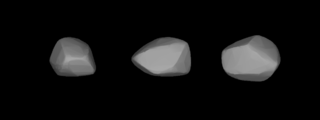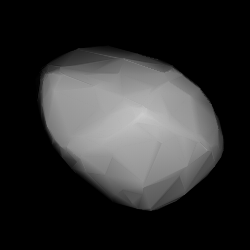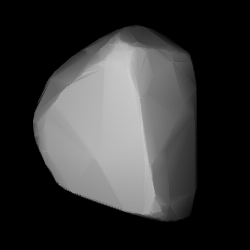Related Research Articles

199 Byblis is a medium-sized main belt asteroid.

312 Pierretta is a 46 km main-belt asteroid discovered on 28 Aug 1891 by Auguste Charlois at Nice.

343 Ostara is a background asteroid from the inner region of the asteroid belt. It was discovered by German astronomer Max Wolf at the Heidelberg Observatory on 15 November 1892.
483 Seppina is a minor planet orbiting the Sun.
510 Mabella is a minor planet orbiting the Sun.

533 Sara is a minor planet orbiting the Sun.

534 Nassovia is a minor planet orbiting the Sun. It is a member of the Koronis family of asteroids.
537 Pauly is a minor planet orbiting the Sun.

543 Charlotte is a minor planet orbiting the Sun. It was discovered by Paul Götz on September 11, 1904, in Heidelberg.
583 Klotilde is a minor planet orbiting the Sun.
593 Titania is a minor planet orbiting the Sun. The name may have been inspired by the asteroid's provisional designation 1906 TT.
609 Fulvia is a minor planet orbiting the Sun.
615 Roswitha is a minor planet orbiting the Sun.

621 Werdandi is a Themistian asteroid.
625 Xenia is a minor planet orbiting the Sun. It was discovered by August Kopff in Heidelberg, Germany, on 11 February 1907. The name may have been inspired by the asteroid's provisional designation 1907 XN.
634 Ute is a minor planet orbiting the Sun.

644 Cosima is a minor planet orbiting the Sun.
726 Joëlla is a minor planet orbiting the Sun. It was discovered on November 22, 1911, by Joel Hastings Metcalf, in Winchester, Massachusetts, in the United States.

819 Barnardiana is a minor planet orbiting the Sun, discovered on March 3, 1916, by the German astronomer Max Wolf in Heidelberg.
2021 LL37 is a large trans-Neptunian object in the scattered disc, around 600 kilometres (370 miles) in diameter. It was discovered on 12 June 2021, by American astronomers Scott Sheppard and Chad Trujillo using Cerro Tololo Inter-American Observatory's Dark Energy Camera in Chile, and announced on 31 May 2022. It was 73.9 astronomical units from the Sun when it was discovered, making it one of the most distant known Solar System objects from the Sun as of May 2022. It has been identified in precovery images from as far back as 28 April 2014.
References
- ↑ "594 Mireille (1906 TW)". JPL Small-Body Database . NASA/Jet Propulsion Laboratory. Archived from the original on 18 September 2020. Retrieved 5 May 2016.